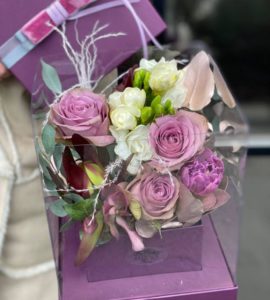The concept of “bouquet” in our culture is practically inseparable from floristry: we are used to understanding it as an armful of flowers, whether it be a composition created by a professional flower business, or a bunch of dandelions collected by a baby for a mother. However, originally the French word “bouquet” had a different meaning – “aroma” or “smell”. Therefore, the first French bouquets were created from fragrant plants, even if their appearance was not spectacular. As a decoration or gift, a bouquet of flowers began to be used in France only since the 19th century.
Currently, there are four main classic types of bouquets, each of which was formed under the influence of fashion trends of the respective era. All of them are used in modern floristry, not yielding to new concepts of beauty and style.
The first bouquets that came into fashion in France at the very beginning of the 19th century had a semicircular or round shape. Such compositions were considered decorative, and the gift options were like a small flower bed: they were concentric rings of contrasting buds, tightly adjacent to each other. Later, bouquets of the pompadour type, slightly elongated from the base, came into fashion. This is exactly what the idea of a classic French bouquet became: a pyramid-shaped composition with a wide base, gradually tapering upward, consisting of a large number of flowers of different sizes, shapes and shades. French flower sketches are placed in vases, jugs and flat bowls.
It is based on plants with long stems and shrub branches that form the frame of the composition.
Dark elements are placed in the far and middle parts of the bouquet, and light ones frame the middle.
The composition is dense and rich, including a wide variety of shades.
Florists use natural materials to decorate French bouquets: shells, feathers, vines.
The historical version of the classic English bouquet is a triangular interior composition with strict symmetry, consisting of beautiful and heavy flowers with expressive and even variegated petals. The Victorian style became heavier over time, and was replaced by an easier style of decorating bouquets – Art Nouveau. It performs asymmetric crescent-shaped compositions and the same triangular bouquets with lightweight filling.
The number of buds in the composition is relatively small, due to which a feeling of lightness and airiness of a floral etude is created.
In bouquets, a frame (including wire) is often used to maintain its characteristic shape.
The filling of the composition is not contrasting, but harmonious. Not only flower buds, but also branches, leaves, stems and fruits of plants can be used as components for a bouquet.
It is believed that it was England that became the birthplace of the culture of creating bouquets not from living plants, but from dried flowers.
A classic German composition – Biedermeier, which is a small dense bouquet of flowers collected from bud to bud, cut exactly at the bottom. The leg of such a bouquet was often framed by a cuff made of tulle or braid, intercepted for secure fixation with a tape. The composition, made in the German style, over time captured wedding trends, remaining the most traditional version of the bride’s bouquet to this day: almost every flower shop offers a Biedermeier for the wedding day. These miniature compositions are easy to hold due to their small size and weight, and their ability to keep their shape well allows you to dry the bouquet in memory of the solemn day.
Live decor. German florists decorate bouquets with cones, berries, leaves and stems of indoor plants: ivy, ficus, asparagus, fern and chlorophytum. Much less often, glass beads, satin and silk ribbons and velvet are used for decoration.
The principle of two thirds: the stem of the bouquet is one third of the total size of the bouquet, and the flower cap rises above the stem by two thirds. The same principle of compositional unity is observed when placing an armful of flowers in a vase: ideally, the vessel should not be more than a third of the resulting composition.
Symmetry. The vast majority of bouquets are assembled according to the principle of strict symmetry, carefully making sure that the finished composition forms the correct hemisphere or circle.
Another version of the German bouquet is Makart’s one: fresh flowers, dried flowers, feathers, large inflorescences, herbs and plant fruits are freely placed in a vase. Elements of such compositions do not adhere closely to each other, however, due to an overabundance of large and heavy parts, they still do not seem airy and are more often used to decorate the interior.
Traditions of composing compositions in the American style were based on the tendencies of European floristry, so the first bouquets combined the fashionable tendencies of French, English and German trends.
Contemporary American floristry is based on a bold combination of colors, unusual shapes and styles. In some bouquets, the influence of the classic English culture of triangular compositions can be traced, but Americans are not afraid to play on contrast, often combining bright contrasting colors (for example, red, blue and yellow) in sketches. American Flower Delivery offers compositions on synthetic moss substrates enclosed in plastic or glass cubes.
Another type of American bouquets is “live jewelry”, which is tiny compositions that are used instead of brooches, bracelets, woven into hair and attached to clothes as decorative accents of the image. Such bouquets are made from living plants, leaves, stems and berries, as well as from dried parts of flowers.



